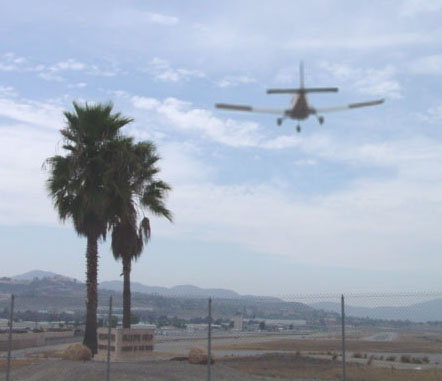
Abstract
Federal Aviation Administration (FAA) officials notified the San Diego County Airport Division that numerous trees had grown tall enough to be considered obstructions in runway approach fans and clear zones adjacent to runways. Failure to clear the obstructions within approximately two months would result in a loss of important federal funding.
For the purpose of planning tree trimming and removal, it was necessary to determine the location of each tree, the elevation of the top of the tree, and the elevation of the approach fan. Trees with tops that pierced the approach fan would have to be trimmed or removed.
Time and cost considerations precluded using traditional surveying techniques. Limitations on trespass on private property was an additional constraint, requiring that data be collected from off-site.
A survey, with accuracy sufficient for the purpose, was conducted using a backpack GPS, corrected with the Omnistar system, a hand held magnetic compass, and a hand held clinometer. Arc Macro Language (AML) was used to perform trigonometric and other calculations to identify trees that met the FAA definition of an obstruction.
Tree locations were plotted on a base map that also showed parcel boundaries and assessor parcel numbers. Airport real property staff then contacted affected owners and assisted in arranging for tree trimming services.

In October 2001, a representative of the FAA visited San Deigo County's Gillespie Field and indicated that there were numerous trees that appeared to be too tall, and appeared to be obstructing airspace for runway approaches. The County Airports Division was given a mandate to survey and remove the obstructing trees.
The time allowed for completion, including tree trimming or removal, was approximately two months. This meant that the County had to deal with a tight time limit and no preallocated budget. The County Survey section was already overbooked, and could not respond in time to meet the deadline. Therefore, the Airports Division and and the Department of Public Works GIS Division devised a plan for an inventory using corrected GPS, hand held compass and clinometer, and ARCINFO.
Following completion of the inventory, the County Real Property Division would contact affected land owners and manage the trimming and removal of the trees.
FAA Regulations specify imaginary surfaces for various classes of runway. Obstructions that are higher than an imaginary surface must be removed or a waiver must be granted. Surfaces are described in FAA regulations (Part 77). Surface specifications are a function of the class of runway and therefore differ from runway to runway.
Surfaces relevant to this project include:
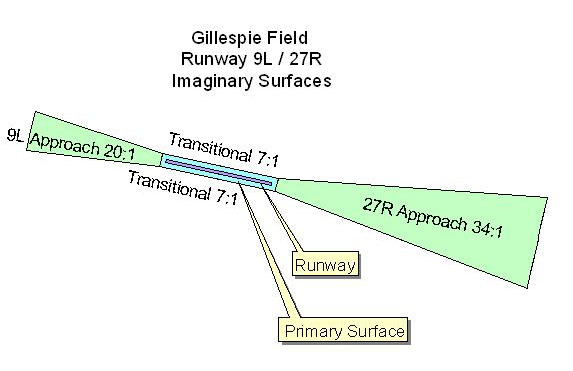
A work map of the airport area was plotted with a digital aerial photo overlain by parcel lines and street names. A preliminary field survey was conducted by Airport Division staff, who noted the approximate location of trees that appeared to be too tall.
The identification of the obstructing trees would consist of three steps:
Location data was collected using a corrected GPS (Geographical Positioning System). The unit used was a SokKia AXIS3 with OmniSTAR correction. Physically, the unit is a backpack unit with an antenna, a receiver, two camcorder batteries and a cable to a Compac Ipac handheld computer.
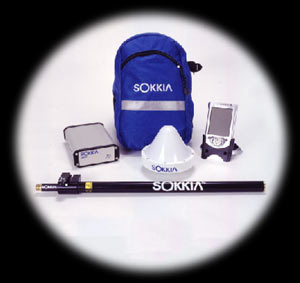
|
SOKKIA AXIS3 GPS
The cone shaped device is the antenna. In use, it is mounted on the pole and cabled to the box, which is the receiver that interprets the signal and calculates position. The receiver is cabled to the Ipac computer, where separate software reads the GPS input and further processes and captures data. Note: The image of the Axis3 system was downloaded from Sokkia's website. |
OmniSTAR provides real time DGPS (differential GPS) corrections to subscribers. OmniSTAR subscriptions require an annual fee. The user does not need to set up and operate a base station. OmniSTAR DGPS corrections are based on a network of ground based reference stations. Correction information is uploaded to a geosynchronous communications satellite that rebroadcasts the correction signal. The AXIS3 uses a feature called "Virtual Base Station" to tailor the correction signal to the GPS receiver location. The vendor claims that accuracy will not degrade with increased distance to a base station. The Omnistar correction signal is a line-of-sight signal that can be obscured by terrain or buildings. The satellite is geosynchronous, being above the equator at 101 degrees W longitude, and in San Diego County, is about 50 to 55 degrees above the horizon in a South-South-West direction (about 157 degrees T).
The AXIS3 can also use USCG radiobeacon correction and FAA WAAS correction. Both of these are free; however we chose the OmniSTAR, despite the subscription fee, because it is less subject to obstruction and provides greater accuracy (1m vs 2-3m).
Sokkia claims submeter accuracy 95% of the time. Time to first DGPS is variable, but is usually less than a minute from a cold start. Ten seconds of occupation of a single position generally seems to provide the claimed 1 meter accuracy.
Quality control on the GPS was done by acquiring survey control monuments that are in the County's GIS database. The experience with survey control monuments appears to confirm the vendor's claims of submeter accuracy 95% of the time. Curiously, we have experienced slightly better accuracy in the z (elevation) coordinate than in x or y. Information from OmniSTAR suggests that you should expect vertical errors of 2 to 2.5 times horizontal errors.
Bearings were acquired by hand held magnetic compass. The magnetic compass was the weakest link in the instrumentation, being subject to several problems:
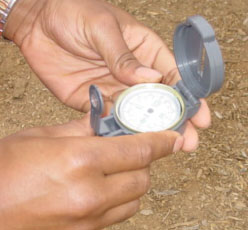
| HAND HELD COMPASS |
Quality control for the compass was by comparison to another compass, and also by shooting runway and road centerlines, which enabled comparison to true bearings, after correcting for local magnetic variation. If the compass was kept away from sources of deviation, such as the above mentioned engine blocks, deviation was zero. Independent readings by different operators were generally within a degree of each other.
The angle above horizontal to the treetop was measured with a clinometer that was purchased for the project. The clinometer allows a split view of a bubble level and the target. The instrument was adjusted by the vendor at the time of purchase. Further quality control was provided by having two people taking independent readings on the same treetop and comparing. In practice, it appeared that repeatable accuracy was within approximately half a degree, with the limitation being the observer's ability to determine when the bubble level was centered.

| SIGHTING WITH THE CLINOMETER |
| SPLIT VIEW AS SEEN IN CLINOMETER
The left side of image is straight through the sight tube,
| 
|
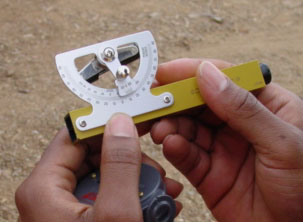
| READING THE CLINOMETER
Whole degrees are read on the main scale; tenths
|
GPS data was collected into a Compaq Ipac hand held computer. Software for field work was Imap, provided by the GPS vendor. Arcpad 6 was not yet available and Arcpad 4 and 5 would not interface to the sokkia GPS. It is possible to configure Imap software to record data in several different coordinates systems and datums. We have configured Imap to record data in California State Plan Zone 6, NAD83 because our other GIS data is stored in that system. Imap will export data as either Esri shapefiles or ascii text. For this project, export to ascii text was used, because that option preserved elevation and correction code data. A programmable vertical offset allows us to collect GPS observation points with the elevation of the ground rather than the antenna. Data was transferred from the Ipac to a desktop PC by using Microsoft Activesync.
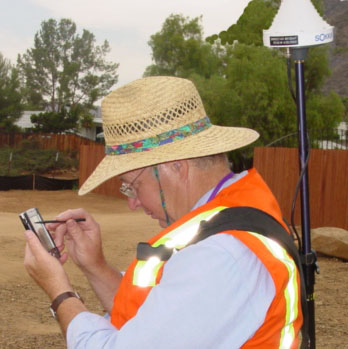
| COLLECTING GPS DATA INTO THE IPAC
GPS data was collected into the Ipac. Data collected
|
Data was collected for clusters of trees, by occupying a location, with the GPS operator placing the heel of his right foot on a mark, like a pebble, and allowing 10 seconds of corrected GPS averaging and then logging the point to the IPAC with an Observation Point identifier. This data collection used Sokkia's Imap software. DGPS can be verified by checking a lock LED on the Axis3 unit, by a visual message in the Imap display, and by synthesized voice messages "Corrected GPS" or "No corrected GPS."
The compass & clinometer operater then replaced the GPS operator, placing his left heel on the same mark and took compass and clinometer readings for one or more trees, while the GPS operator recorded the observations in a notebook.
The team then moved to a second location to observe the same trees, and repeated the procedure.
Data was organized in two text files, one with observation points and the other with tree data.
Observation points were in a file, created by exporting from Imap, with one line per point as follows:
pointnumber, y, x, elevation, name
Example (data for 2 observation points):
1,1881065.7505266,6343649.2749577,427.479,'Obs 1'
2,1881414.2322601,6343622.5847365,430.070,'Obs 2'
Tree information was placed in a file with information on each tree occupying 3 lines as follows:
Tree_name
Obs_pnt_num,magnetic bearing, angle above horizontal
Obs_pnt_num,magnetic bearing, angle above horizontal
Example (data for one tree):
'teton pine'
1,124,11
2,34,17
Arcinfo 7.2 amls were written to read these text files and and create two coverages: one with observation points and one with intersecting bearing lines and tree points. These amls were run in Arcedit.
Bearings were converted from magnetic to true by adding the local magnetic variation of 14.5 degrees. This resulted in an angle clockwise from true north. That angle was then converted to an angle counterclockwise from true east. The slope (m) of a linear equation representing the sightline is the tangent of the angle counterclockwise from true east. (Note: the aml function [tan <angle>], requires the angle argument to be in radians.)
Equations in the form y = mx + b were derived for each observation point and bearing. The resulting pair of simultaneous linear equations was solved and a point attributed with the tree name was added to the coverage at the x,y coordinates of the solution.
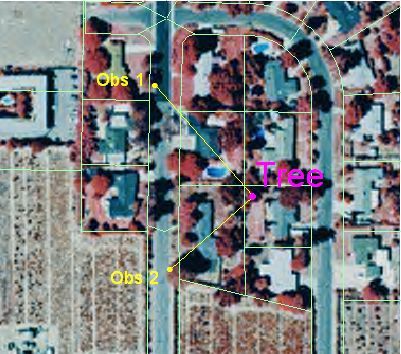
| TREE LOCATION BY INTERSECTING SIGHTLINES Two observations from the street enable determining the location of at tree in a private backyard. The x and y of the tree were calculated using an analytic geometry approach.
|
An alternative, and preferable, approach to solving for the tree locations could have used COGO. The edit coverage must have COGO attributes. The Arcedit COGO command is:
LOCATE POINT <XY> BEARING <BEARING> <XY> BEARING <BEARING>
The COGO approach uses fewer steps. In particular, it uses bearings directly, without converting to counterclockwise from East (but does require converting MAGNETIC to TRUE). It also has the advantage of dealing with the special case where the true bearing is 0 without error trapping. (The special case did not occur in this project.)
The height of the tree top above the observor's eye is calculated by
h3 = d*tan(theta)
where
In each case, the observation that was nearer the tree was used for this calculation.
The elevation of the tree top was calculated as follows: Elev(treetop) = elev(obs pt) + eye height + h3
Where:

| SIDE VIEW OF TREETOP ELEVATION FROM OBSERVATION POINT |
This data collection and analysis process resulted in a coverage with tree locations and the elevation above mean sea level of the treetops.
Given the locations and elevations of the treetops, it was then necessary to compare each treetop elevation with the elevation of the applicable FAA imaginary surface.
A detailed and careful reading of FAA regulations yielded descriptions of a set of imaginary surfaces for each runway.
Example:
The approach surface footprint for runway 27R begins 200 feet east of the displaced threshold, extends 10,000 feet eastward. Width is 500 feet at the west end and 3,500 feet at the east end. Slope is 34:1. Elevation ABOVE RUNWAY ELEVATION of the surface at any point was approximated by
h2 = d/slope where
Note that it would be strictly correct, based on the FAA description, for d to be the distance from the tree location point to the line (extended) marking the western end of the fan. In the worst case, for trees closest to the runway and farthest from the centerline, the approximation overstates h2 by a little over a foot. For most trees the error due to approximation was much less.
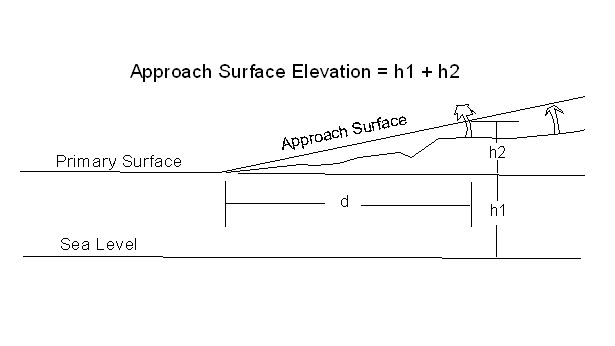
The elevation of runway 27R is 385 feet above mean sea level, so the elevation of the surface was 385 + h2, or 385 + d/34.
For each tree, if the treetop elevation was higher than ANY imaginary surface elevation, the tree was identified as needing to be trimmed, and the amount of height to be trimmed from the tree was calculated.
Maps were produced using ArcPlot, showing fan boundaries, trees, parcel boundaries, and street names, all overlaid on a geo-orthorectified digital aerial photo. Trees were identified by number. A table listing trees, treetop elevation, fan elevation, and the amount of needed trimming was prepared. This information was provided to staff of the County's Real Property Division, who would be responsible for arranging the tree trimming.
Real Property Division staff responded by requesting that the "after-trimming" height of the treetop from the ground be added to the table. This was somewhat of a problem, since, in most cases, the location of the tree had not been occupied, and therefore the elevation at the base of the tree had not been collected. In most cases, the elevation of the nearest observation point was used as a base elevation, and in a limited number of cases, the tree was revisited and a corrected base elevation was collected or estimated. The revised table provided the Real Property Division with the information they needed for the project.
Real Property staff made one additional request. They asked for a general "height above ground" limitation for tree height by neighborhood, for future use in managing the trimming of growing trees. This additional request was declined when it was determined that sloping terrain made it impossible to provide a single valid number for a neighborhood.
Owners are legally responsible for trimming their trees so that they are not obstructions. In some cases, the ownership of a tree could be determined by examining the map, however many tree crowns straddle property lines, so ownership was determined in the field by observing the location of the base of the tree.
A number of owners objected that they doubted that their trees were, in fact, obstructions. Airport staff provided a tour, enabling owners to stand at the end of the runway and look back toward their homes. The tall trees were conspicuous and the property owners could recognize their trees and generally accepted the conclusion that they were obstructions.
The discussion quickly shifted to questions along the lines of "the trees have been here for a long time; why right now and why the hurry?" The answer, of course, was that the FAA wants the obstructions cleared now and that's why the hurry. While not happy about trimming their trees, or in some cases entirely cutting down their trees, nor happy about the expense, most of the affected property owners gracefully accepted the situation.
The Real Property Division then arranged a bulk contract with a tree trimming firm. Individual homeowners were free to join the contract, or arrange trimming by a contractor of their choice. Most chose to join the contract because the terms were more favorable than they could negotiate on their own.
Only one homeowner has not agreed, and is applying for an FAA exemption.
FAA regulations specify sloping imaginary surfaces, above which airspace must be keep clear. When growing trees pierced the imaginary surfaces in the vicinity of Gillespie Field, County government was required identify the offending trees, determine how much had to be trimmed from the top of each and cause the trimming to take place.
A contemporary GPS unit with a data collector, combined with simple compass and clinometer, allowed a 2 person crew to collect data in the field. Workstation ArcInfo, relying on Arcedit and procedural programming in Aml was used to analyze the data. A combination of analytic geometry implemented in Aml and Arcedit COGO commands was used to construct fan footprints, and to determine tree locations, treetop elevations and fan imaginary surface elevations.
This combination provided accuracy adequate for the purpose, cost effectiveness, and the necessary rapid turn-around.
When obstructing trees were identified, the SanGIS parcel database provided ready access to ownership information. The County Real Property Division contacted owners and coordinated the trimming or removal of obstructing trees.
Sokkia Axis3 Operations Manual
http://www.sokkia.com
http://www.omnistar.com
FAA Regulations PART 77
http://aa.usno.navy.mil/data/docs/AltAz.html
This web site was used to estimate azimuth information for the OmniSTAR satellite
by calculating azimuth to the sun at 11 am local time for Mar 21, 2002. At that time
and date, the sun is over the equator at 101 W Longitude, same as the correction satellite.
Eric Nelson is an Engineer in the Airports Division. He was the lead responsible staff for the overall project to identify and trim the obstructing trees. He also took on the task of intrepreting the Part 77 regulations, classifying the function of each runway and determining the dimensions and slope of the various surfaces.
Mike Binge is the DPW GIS Section Manager. It was through his effort that DPW/GIS acquired GPS equipment and applied it to current projects.
SanGIS is a joint powers agency of the City and County of San Diego, responsible for maintenance of and access to regional geographic databases. This project made use of data from the SanGIS data warehouse, particularly the parcel coverage.